1787 Search Results for video of the week
October 4, 2016
by Carole Zangari -
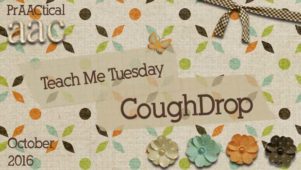
We’re back with another post featuring learning resources about AAC apps, software, and SGDs. This week, we’ll look at CoughDrop, an open source AAC program, and hear from a young clinician who uses it in her work. If you are new to CoughDrop, consider taking a little time to get to know it using the links below. Ready to explore? Here are some resources to get you started. Video overview Links to various versions: iOS app; Android app; Windows 64-bit; Windows 32-bit; Kindle app Video Tutorials Where to go for help: Support Requests; Contact page; Frequently Asked Questions My Experience with CoughDrop by Samantha Cutler Primarily, I’d like to issue a disclaimer that I am in no way affiliated with CoughDrop nor do I receive any financial gain from them. It is merely a program that I enjoy using and I wanted to share my experience with the AAC community. In the... [Read More...]
October 3, 2016
by Carole Zangari -
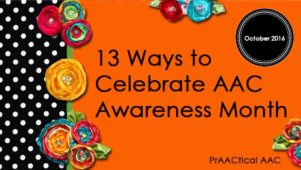
Need some ideas for celebrating AAC Awareness Month? Here are a few to get you started. Participate on the #USSAAC Twitterchat on 10/13 at 7:00 pm EDT (UTC−04:00). New to Twitterchats? You can learn more here. The wonderful Chris Bugaj will be moderating. Subscribe to a blog with an AAC content, such as Uncommon Sense, Jane Farrall Consulting, AAC Girls, or Superpower Speech Follow a new AAC topical Pinterest board from Lauren Enders and others: AAC and AT, AT/AAC/Adapt/Modify/Accessibility/Accommodations, AT for Communication, SLP AAC, & AugComm, AAC by Constantly Speaking, Communication-AAC Print, hang, or give someone an AAC awareness image, 10 Commandments of AAC Devices, or 5 Tips for Communicating with Nonverbal Student Register for a free AAC professional development webinar from Ablenet University Print out an AAC Poster, like Lauren Enders’ AAC Boot Camp-Getting AAC Users to Communicate or Kate Ahern’s The Periodic Table of AAC, Explore an AAC app or SGD that is new to you Print out song visual... [Read More...]
August 15, 2016
by Carole Zangari -
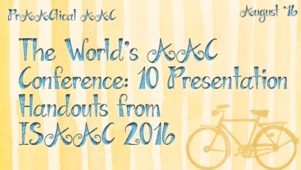
It was so wonderful to meet and learn from so many colleagues and families at the 2016 ISAAC Biennial Conference last week. What an amazing experience to participate in an AAC event withcolleagues from 40 countries! ISAAC 2016 really was the world’s AAC conference. There was an active Twitter thread with a running account of the activities in sessions, social events, and the exhibit hall (see tweets from #ISAAC2016 here). The opening ceremonies started off strong with Vic Valentic’s performance (using AAC) of “I’ve Got a Lot to Say,” a song written by Vivian Butch. You can learn more about their collaboration and see an earlier performance of that song here. Keynote speaker John Draper, founder of Together We Rock, then gave a funny, engaging talk that addressed the contributions of clinicians, educators, researchers, and technologists alike. I was honored to be invited to present two pre-conference sessions on Day 1... [Read More...]
July 18, 2016
by Carole Zangari -
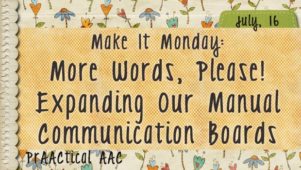
It’s another Make It Monday, our series on preparing core vocabulary materials for use with AAC learners. When we left off last week, we selected or created manual communication boards (MCBs) with a starter set of core words. Today, we pick up that thread by adding more words. If you are working with teams that are new to AAC implementation, have a difficult time with change, or are showing resistance to this “whole AAC thing,” you might want to start off slowly and use just the main communication board for a few weeks to build everyone’s confidence. You can add more words once they are implementing it fairly well. The way I see it: Strong implementation of a basic core board is better than weak implementation of a more robust board. It doesn’t take very long, though, to realize that as versatile as our core word MCB is, there simply... [Read More...]
June 1, 2016
by Carole Zangari -
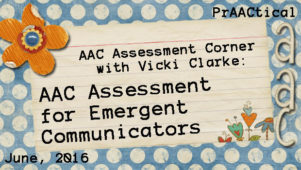
Today, we welcome back Vicki Clarke with more helpful information on conducting AAC assessments. If you work with individual who are at the early stages of communicative development, this post is for you! :::::::::::::::::::::::::::::::::::::::::::::::::::::::::: Some of my most favorite students are those who, at first, may not seem to notice me at all. Sometimes these students seem to exist in their own worlds. They don’t seem to respond in ways we would expect: looking, attending, listening, or gesturing. They may have a diagnosis of Autism, significant developmental delay, epilepsy, or any number of syndromes. I love these kids, and unfortunately, these are often the students who don’t get referred to me. Sometimes it takes years of working in a district before I get to see students with significant developmental delays. These children are typically served in classrooms for students considered to be severe/profound or multi-handicapped. Honestly, I usually get the... [Read More...]
February 8, 2016
by Carole Zangari -
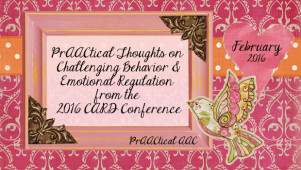
Last month, I had an opportunity to hear Dr. Barry Prizant, Director of Childhood Communication Services and Adjunct Professor at Brown University, at the 2016 Center for Autism and Related Disabilities Conference. Many of you know Dr. Prizant as co-author of SCERTS, the Social Communication Emotional Regulation Transactional Supports Program, and his recent book, Uniquely Human, discussed in this video. At this conference, he spoke on ‘An Emotional Regulation Approach to Preventing Problem Behavior.’ Here are some points of interest from his presentation. Dr. Prizant suggested that when someone is dysregulated, the first thing we should think about is biological factors that may be causing or exacerbating the problem. Why? Because unless we address the root of the problem, chances are slim that any behavioral, communicative, or psychological strategies will be effective in the long run. In some cases, there is a rather straightforward solution, such as teaching our client... [Read More...]
February 2, 2016
by Carole Zangari -
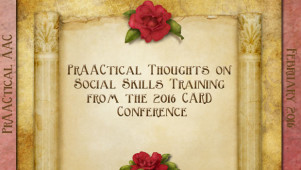
I had a wonderful time this past weekend connecting with colleagues and learning from ASD experts at the 2016 Center for Autism and Related Disabilities (CARD) Conference in Orlando. One of the keynotes, “From Building Social Relationships to Improved Quality of Life Outcomes for Youth on the Autism Spectrum: We Finally Know What We Already Knew,” was given by Dr. Scott Bellini. I also attended his talk on the Building Social Relationships program. Here are some of the take-aways from those two sessions. Evidence Base The evidence base for social skills training is variable. While his meta-analysis on school-based social skills training found that social skills interventions were minimally effective, there are several effective strategies that can be used in that and other settings. When evidence-based strategies, including video modeling and video self-modeling and social narratives, are used within the context of social skills training, the overall efficacy is much greater. The evidence... [Read More...]
January 18, 2016
by Carole Zangari -
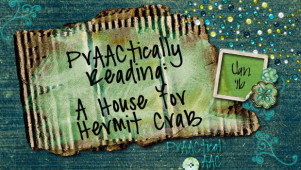
Storybook reading is rich with potential for building AAC, language, and literacy skills. An added bonus: It’s an activity that educators, therapists, and families can all use and enjoy. In this post, we explore ways to use A House for Hermit Crab, by Eric Carle, for AAC and language learning. Key Instructional Strategies Having an engaging book gives us a good start on the lesson, but the learning comes from the interaction. Shared reading can be done in therapy one-on-one or as a group in class. Either way, the adult leading the activity will need to be well-versed in instructional strategies that facilitate AAC learning. These include: Aided language input RAAP Feedback Goal Areas: Language and Communication There are lots and lots of ways to use this book for literacy learning, but in this post we’ll focus more on the development of communication and language skills. Here are some goal... [Read More...]
December 22, 2015
by Carole Zangari -
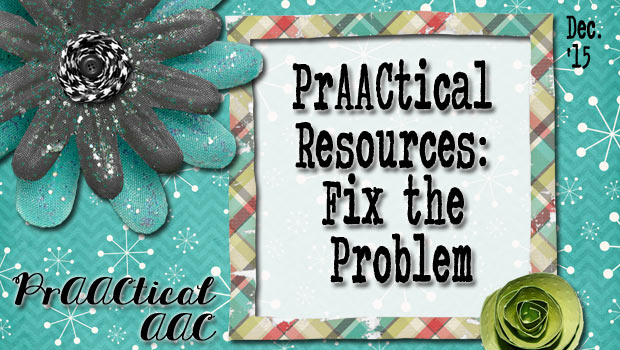
Joel Shaul, of Autism Teaching Strategies, has been so generous in sharing the creative resources that he has developed over the years. In this post, we take a look at Fix the Problem, a game that he created to support learners who have difficulty in social situations. The game board, playing cards, tokens (play money), and other materials are all free downloads. You can get them here. If you download and use these materials, please consider heading back to Joel’s website to leave a comment, provide feedback, or share a photo. Enjoy! You can see more of Joel’s work here.
December 1, 2015
by Carole Zangari -
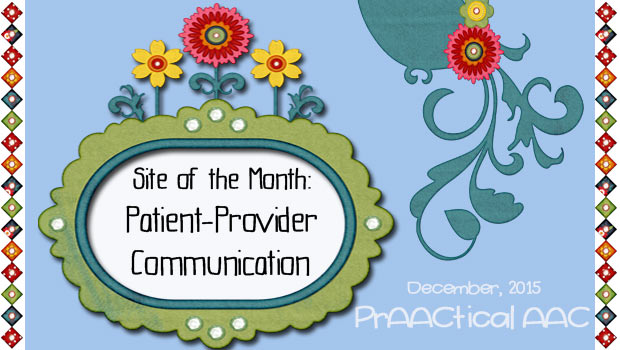
Doctor appointments, feeding tube placement, ear check, blood pressure, suctioning, IV medication, oxygen through a nasal cannula, trach changes, blood work No matter what the age or type of disability, almost all AAC learners face the challenge of communicating effectively during encounters with healthcare professionals. People with AAC needs are among those who are considered to be communication vulnerable and do best when there are planned supports in place. The Patient-Provider Communication (PPC) website hosts projects and resources to improve interactions between people with communication challenges and their healthcare providers. It is also the online home to a group of professionals across the globe who share information and collaborate to improve communication at physician offices, clinics, emergency rooms, acute care and rehabilitation hospitals, intensive care units, home health services, and hospice facilities. It is funded by the Central Coast Children’s Foundation and directed by AAC pioneer Dr. Sarah Blackstone and... [Read More...]









